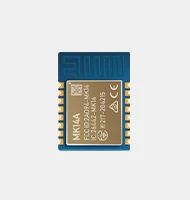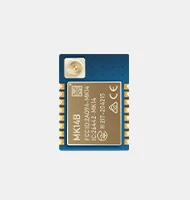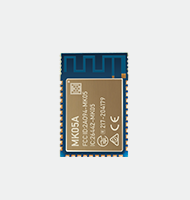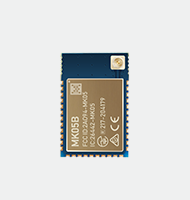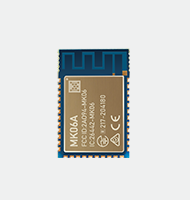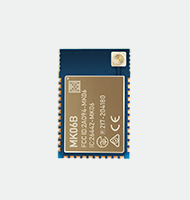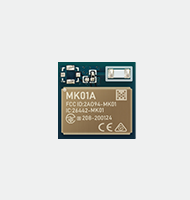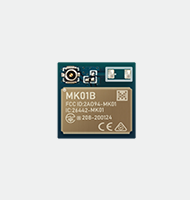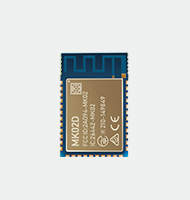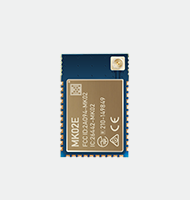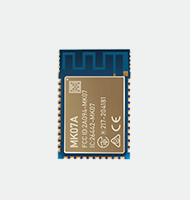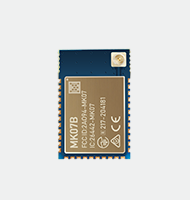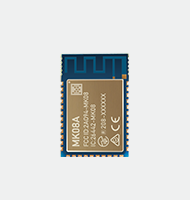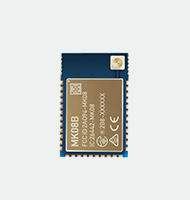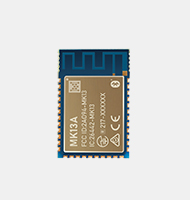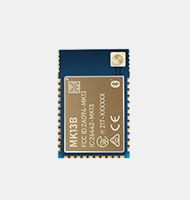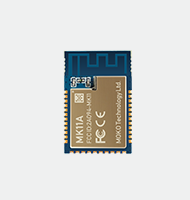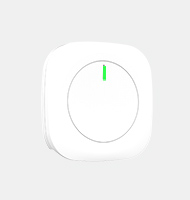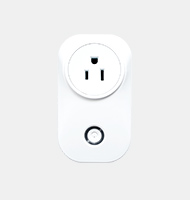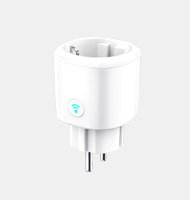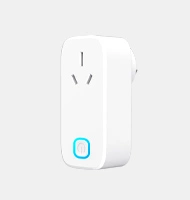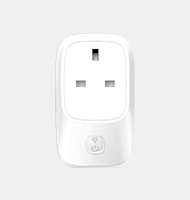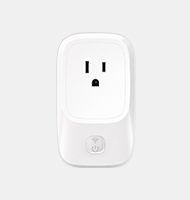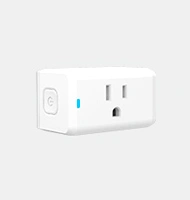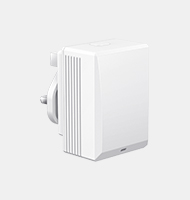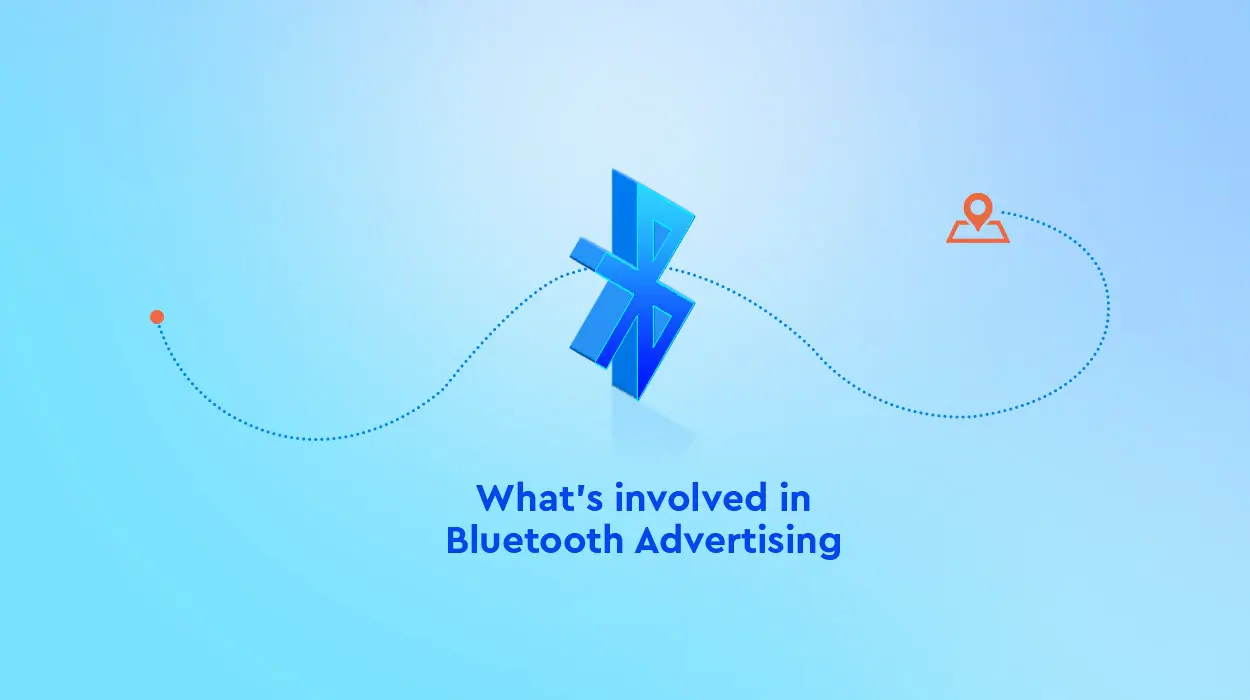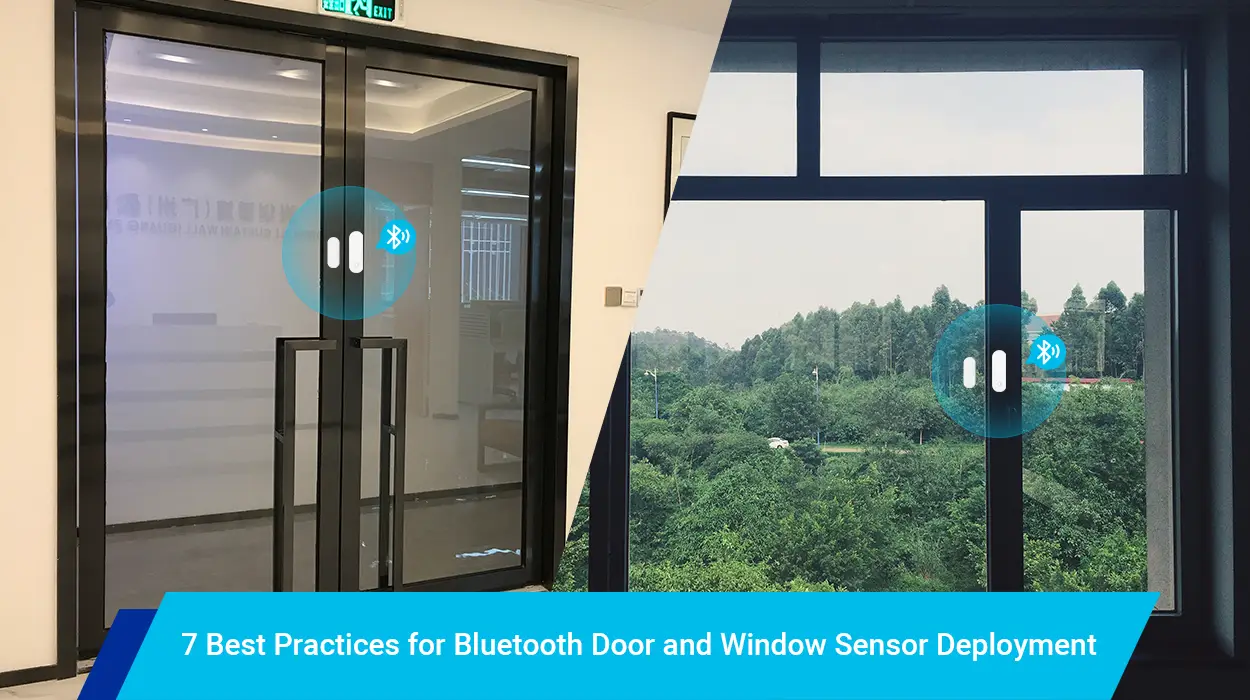BLE advertising is an important part of Bluetooth low power technology. Whether it’s a beacon that sends weather, location, or a fitness tracker that’s permanently connected to a host (phone or tablet), it all starts out as an advertising model. Knowing how to use ads correctly enables you to reduce power consumption, increase the speed of connections, and improve Bluetooth advertising reliability. BLE advertising is also key to beacons, which are becoming increasingly popular for creating location and tracking. The principle and usage of beacon advertising will also be involved in this article.
There are two ways to communicate Low Power Bluetooth. The first one is to use advertising, where BLE peripheral devices broadcast packets to every device around them. The receivers can then manipulate or connect with this information to receive more information. Bluetooth beacon communicates in this way, they just transmit the data packet. The second way is to receive packets with a connection, in which both peripheral and central devices transmit packets. Bluetooth advertising is the topic that we’ll focus on due to the following reasons:
- Without advertising, a connection can not be created between two devices. The first thing you need to do is set a definition of the format and data of an advertising packet when developing a Bluetooth low energy device.
- A lot of BLE products remain on standby in most of the time, they wake up for advertising and connecting only when needed. That means advertising has a big impact on electricity consumption.
- Users require responsive products, and advertising spacing is critical for fast connections.
- Advertising is at the heart of Eddystone, iBeacon, and other beacons.
Advertising is designed in one direction. Without a connection, the central device cannot transmit data to the peripheral while a peripheral can advertise to multiple hosts in the zone.
Bluetooth low energy physical layer
Before discussing how AD packages are sent, here’s some knowledge about the BLE physical layer you should learn first. The physical is actually responsible for sending signals in the air. This includes actual radio frequency radios.
There are some similarities between Bluetooth low energy and classic Bluetooth. Both of them use the 2.4ghz band and 1Mbps GFSK modulation, but the modulation index is different. Classic Bluetooth has 79 channels, while LE has only 40. The spacing of channels is also different. That’s why BLE and classic Bluetooth can’t communicate as they’re incompatible.
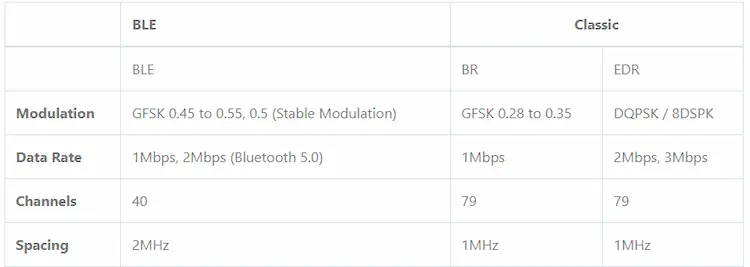
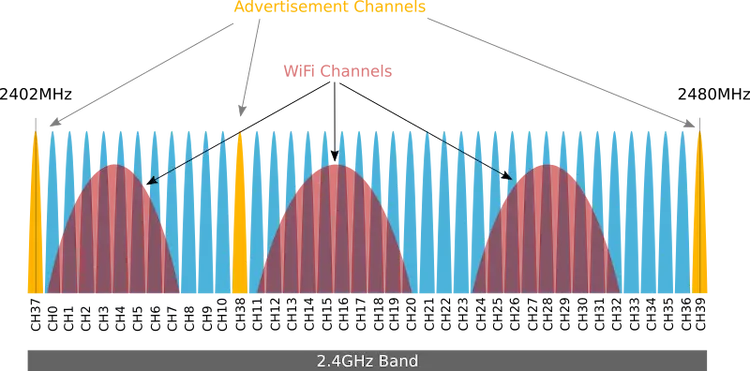
Bluetooth’s 2.4ghz band expands from 2402MHz to 2480MHz. The wide channels LE uses are 40 1MHz with 2MHz intervals.
Channels 37, 38, and 39 are used to transmit advertising packets only. The rest is used for data exchange during the connection. It’s important to note that in the latest Bluetooth specification, the AD extension also allows advertising using other channels, but we’ll focus on the three main channels first.
During BLE advertisement, BLE peripherals send the same packets on three advertisement channels in sequence. A central device that scans devices or beacons will listen for advertising packets on these channels, which helps it spot nearby devices.
Channels 37, 38, and 39 are deliberately distributed in the 2.4ghz band. If anyone advertising channel is blocked, the others may still be available because they are separated by a considerable amount of megahertz bandwidth. This is especially true because most other devices interfere with BLE being a narrow band. The wide spacing of advertising channels helps Bluetooth low energy better manage interference from Wi-Fi, microwaves, classic Bluetooth, baby monitors and etc, ensuring the success of advertising.
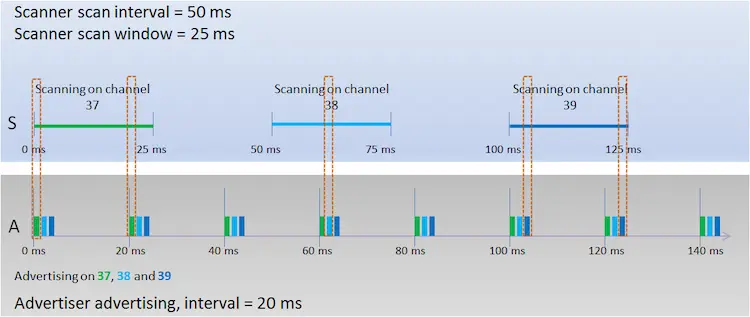
BLE Bluetooth Advertising interval
When BLE peripherals are in publish mode, messages are periodically sent on each publish channel. The interval between packet sets can be either a fixed interval or a random delay.
The fixed interval ranges from 20ms to 10.24 seconds, and the step is 0.625ms. The random delay is automatically added from 0ms to 10ms. This randomness helps reduce the likelihood of AD collisions between different devices (if they have the same drop rate, they are easier to interfere with). We mentioned that finding ads is crucial, so it’s important to avoid conflict.
You might want to save power consumption by advertising on just one or two channels rather than all three since each packet sent has a specific cost, which can greatly increase the average current. Most companies are not in favor of this approach because of the disruption. If the channel you selected is blocked, your device will not work. For instance.
Moreover, the AD interval is separate from the connection interval. So even if your device has a slow connection, you will not be prevented from sending data quickly once the connection is established.
Even though there are wide advertising intervals, most devices use the following guideline:
- Less than 100ms – for very aggressive connections and short periods of time
- 100ms to 500ms – fast advertising for most devices
- 1000ms to 2000ms – for devices that connect to gateways and where latency is not critical
Be aware that connections may require multiples of AD intervals. In fact, most devices create a more sophisticated advertising system that uses both fast and slow advertising models. Because the user has already interacted with the device, the device launches or is told to start playing ads at a faster rate. In response quickly, it should be done in a limited time.
After a pre-set period of time, when no connection occurs, the device switches to a slower advertising rate, which allows applications to connect but limits power consumption as the user may need some time to connect.
Advertising channel PDU
The AD channel PDU itself has payloads that depend on the type of AD PDU. This payload has a 6-byte AD address with a variable number of AD data structures.
After taking into account the AD address (which is often referred to as the Bluetooth MAC address, although it can change at will), we are left with the actual AD data structure of 37-6 = 31 bytes. This must be consistent with the length, type, and data itself.
As you can see, BLE contains lots of data, which makes it flexible for you to support the different behaviors that are most suitable for your product. At the lowest level, ads are 31 bytes long and can publish any number of different content.
BLE advertising package
The Bluetooth specification set the definition on the top-level packets in Ble with two data units. The package itself has several parts, including the lead and access addresses, and the CRC.
The AD channel packet data unit consists of a 2-byte header and a payload that vary from 6 to 37 bytes.
As below are several types of PDUs for advertising:
- ADV_IND
Also called an AD directive (ADV_IND), the peripheral asks to connect to any central device (that is, not to a specific central device).
For example: a smartwatch requests to connect to any central device.
- ADV_DIRECT_IND
Connection requests are directed to a specific central device.
For example: a smartwatch requests to connect to a specific central device.
- ADV_NONCONN_IND
Unconnected devices, advertising messages to any listening devices.
For example, a beacon in a museum is used to determine proximity to a particular exhibit.
- ADV_SCAN_IND
Additional information is provided through the scan response.
Example: Warehouse pallet beacon, which allows central equipment to request additional information about pallets.
To broadcast general data without establishing a long-term connection, set THE PDU type to ADV_NONCONN_IND or ADV_SCAN_IND. A typical beacon will use ADV_NONCONN_IND.
Proximity range of Bluetooth advertising
Bluetooth advertising is generally a broadcast feature. For most Bluetooth mobile devices, the average range of the second type of Bluetooth ads is 15 meters to 40 meters. Just like many wireless transmissions, the accessibility, and range of most Bluetooth advertising hinge on the individual portability and transmitter power level of the receiving device. However, with the advancement of mobile device technology, the distance is increasing to more than 250 meters in order to receive information correctly on mobile devices such as smartphones and tablets. Selectivity decreases as the range increases, so an increase in transmitting power and receiver sensitivity reduces the contextual connection between the actual position of the receiver and the content of the broadcast message. There are several major Bluetooth advertising solutions. This is usually Bluetooth dongles as transmitter hardware, combined with most USB-connected normal server functions. Embedded scheduling software transmits via a dongle to an enabled Bluetooth receiver. Since Bluetooth reception mode requires battery power, its allocation depends on whether the receiver unit holder is ready to receive this transmission.
Bluetooth Advertising extension of Bluetooth 5.0
While Bluetooth 5.0 is known for its longer battery range and higher data throughput, Bluetooth 5’s advertising extensions will help provide an even better experience. BLE Advertising doesn’t just send AD data across 3 AD channels, it allows you to link AD packages together and use 37 other channels that didn’t previously carry AD data. This is helpful in getting AD data even when lots of interference maintain.
Bluetooth 5 also allows AD packets to contain 255 bytes of data, which is much larger than the 37 packets that are possible in Bluetooth 4.0 through Bluetooth 4.2. This enables it to get data without a connection, which saves power consumption.
Bluetooth advertising application
- Broadcast location-based coupons
- Contextual Ads
- Localized information
- Play & Music
- Content requirements
- Specific and targeted activities
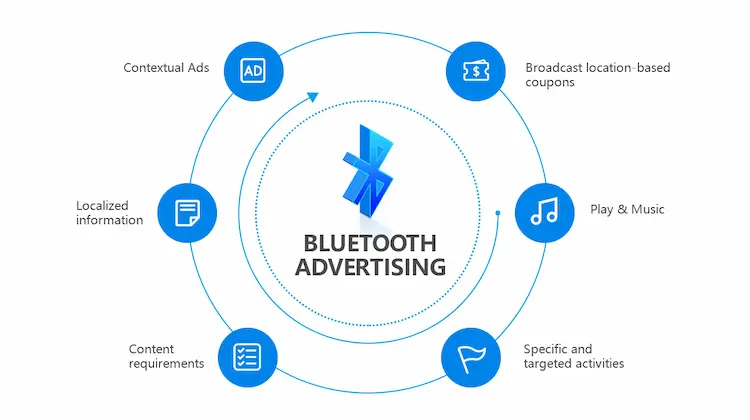
BLE beacon and ibeacon
No discussion of BLE Advertising would be complete without a discussion of Beacon, specifically Apple’s iBeacon standard.
Beacons are BLE peripherals that only use advertising and do not allow connections. The reason for not allowing the connection is that if the beacon were to establish a connection, the advertising would have to stop, so other devices could not find the beacon. The format of the sent packet was inconsistent. Procedure Apple’s iBeacon uses a very specific payload format.
![]()
These ibeacon packets use a basic BLE format. Let’s take a look at each one.
The AD message contains Bluetooth MAC address and payload. The payload consists of two AD structures, the first using Flags data type to provide general information, and the second one is Apple specific iBeacon information.
IBeacon Data type
The second type of advertising is the most important. The first byte represents the number of bytes, 0x1A represents a total of 26 bytes, a load of 25 bytes, and a type of one byte.
The first two bytes represent the company identifier. The last two bytes are beacon notification indicators. They’re always 0x02 and 0x15. The key field is the iBeacon adjacent UUID, which uniquely identifies the iBeacon, followed by the primary and secondary fields. There are unique UUIDs for each iBeacon so that the iPhone application knows exactly where it is relative to one or more ibeacons. Finally, the calibrated TX power also has a supplement of 2, which can be used to improve positioning accuracy and know the power level of the beacon.
What is Beacon Advertising?
Beacon advertising (also known as “beacon marketing”) is a form of advertising that uses a small, battery-powered transmitter called a beacon to send a short-range signal to a mobile device via Bluetooth. Using the technology, store owners and others can collect data or deliver personalized, location-based ads to people in or near their stores.
MOKO Beacon Bluetooth Advertising use cases
MOKOBlue has over 16 years in proving ibeacon solutions. Here are some ways to use Bluetooth beacon advertising effectively.
- Indoor ads: Shoppers browsing the goods at their local supermarket will receive a mobile notification of a deal on their favorite brand. Real estate agents will also use beacons on for-sale signs to provide property details to potential buyers. Beacon marketing enables you to target mobile promotions based on past actions and location, which makes it more likely that the recipient will take action.
![]()
- Personalized ads: Advertisers can integrate beacons with proximity marketing. This type of integration provides more data about shopper behavior. So when someone comes into the store, you can give instant reception, offer recommendations based on past browsing or buying behavior, offer targeted deals via mobile notifications, or improve your sales strategy accordingly. Beacons can also help events run more smoothly by helping organizers identify the busiest stalls and alerting people to what is happening nearby through automatic registration and registration.
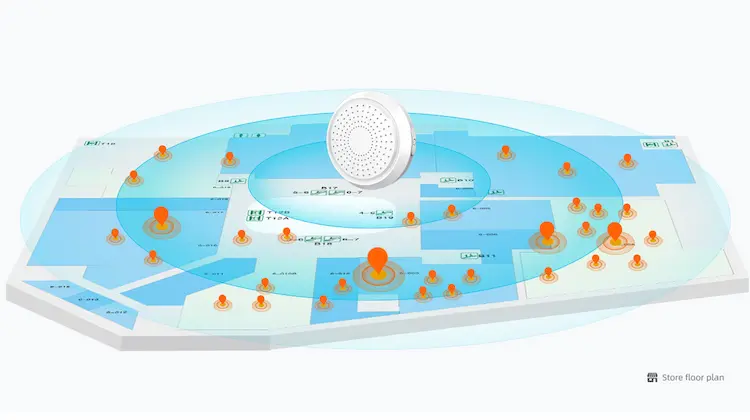
- Seamless check-in: Advertisers can also utilize the integration with location technology to make check-ins by detecting the location of one individual. You can also use beacons to serve retargeted ads to those who need more encouragement to buy.

